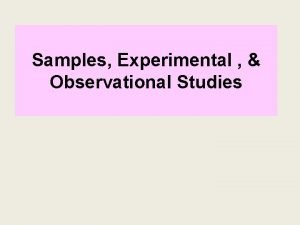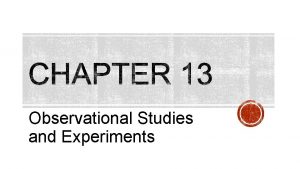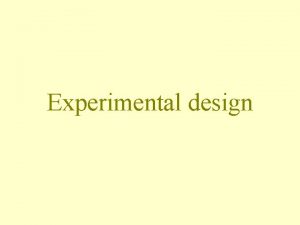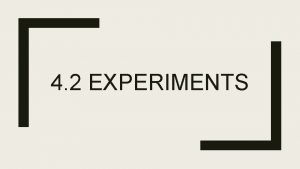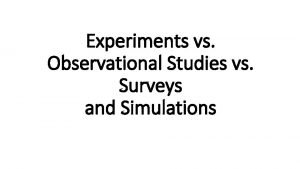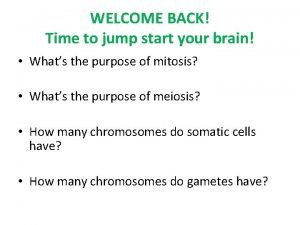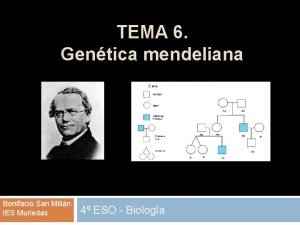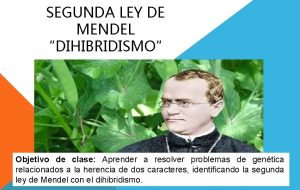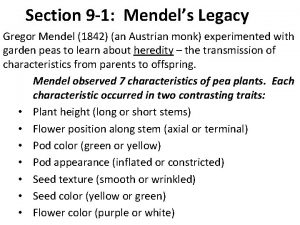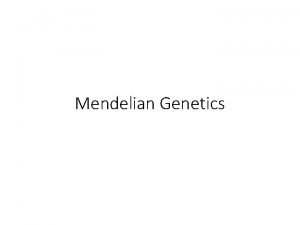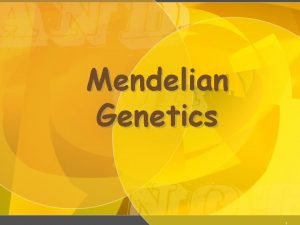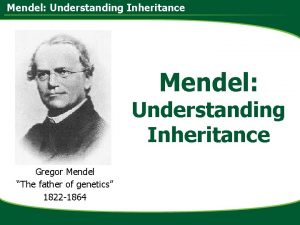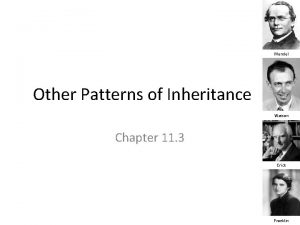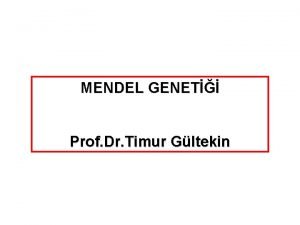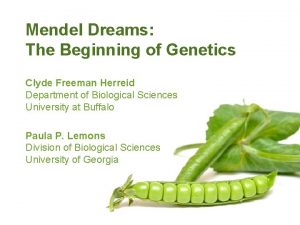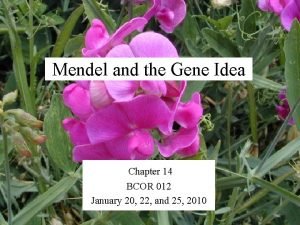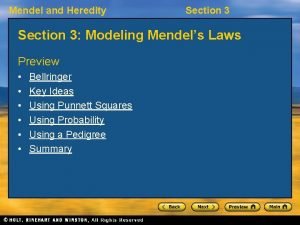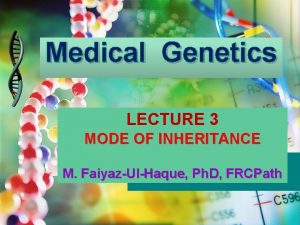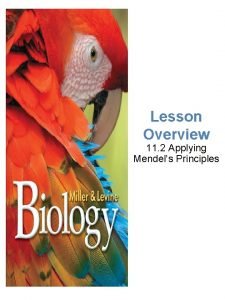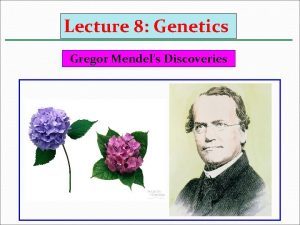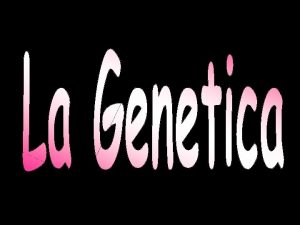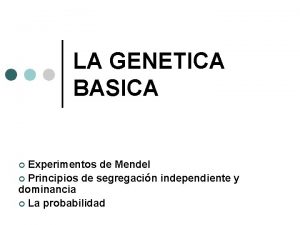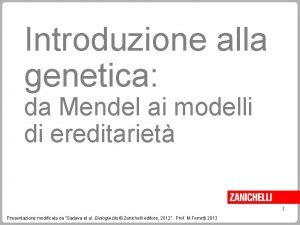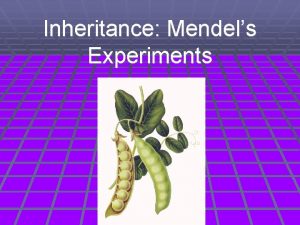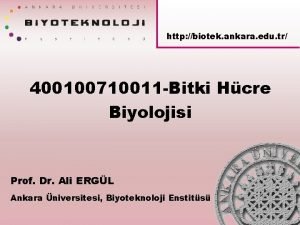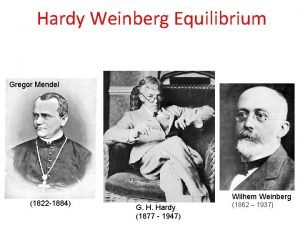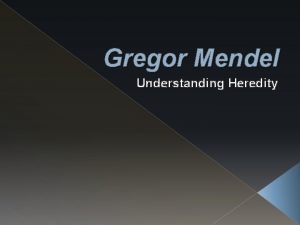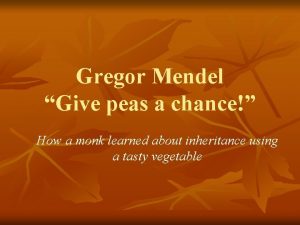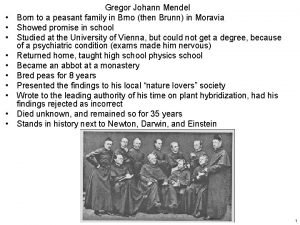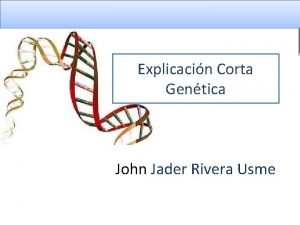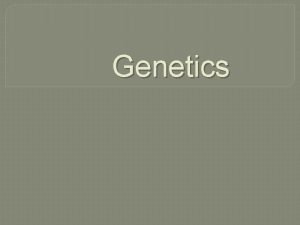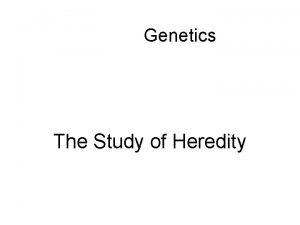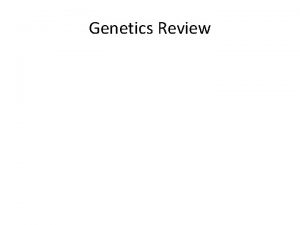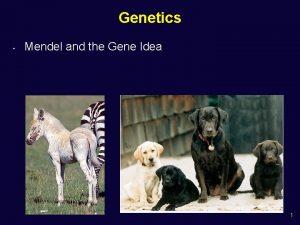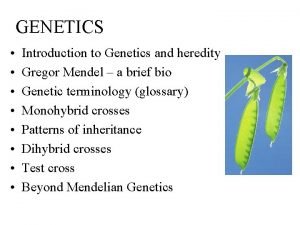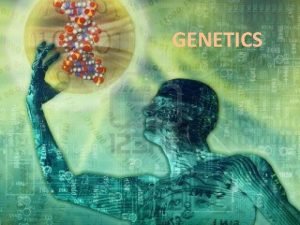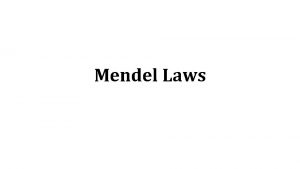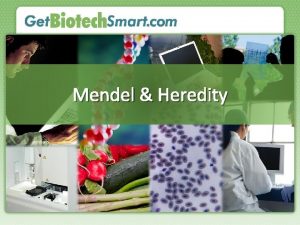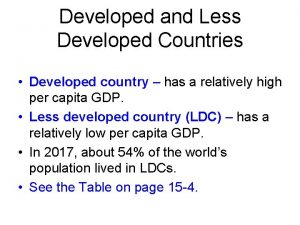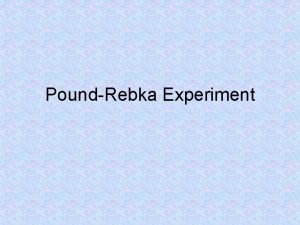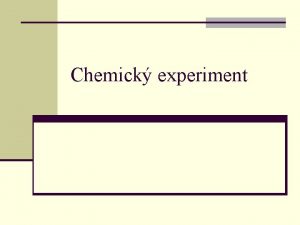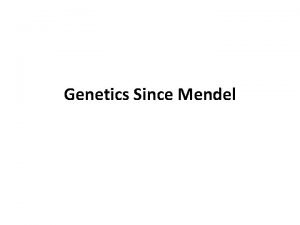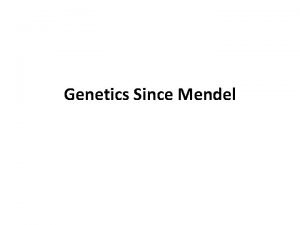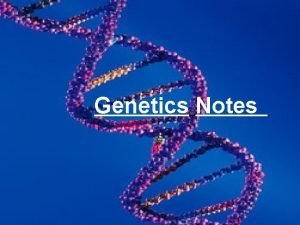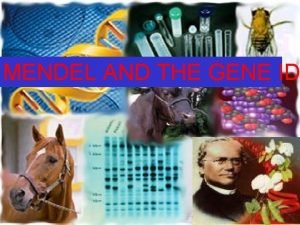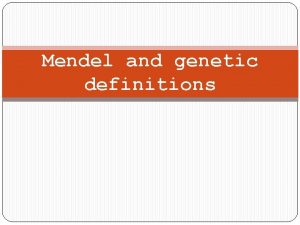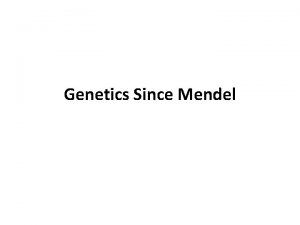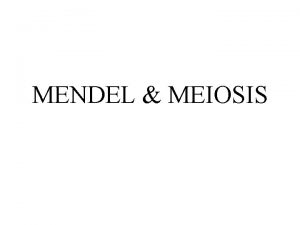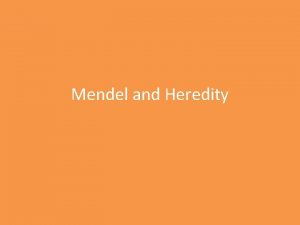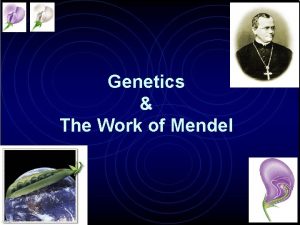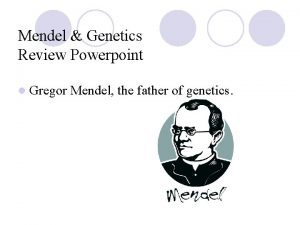Gregory Mendel Gregory developed own experiment to study



























































- Slides: 59




Gregory Mendel • Gregory developed own experiment to study different traits in peas • First scientist to study genetics • “Father of Genetics”

Genes • Units of information about specific traits • Passed from parents to offspring • Each has a specific location (locus) on a chromosome

Alleles • Different forms of a gene • Each person has at 2 alleles for each trait • 2 types • Dominant (A) • Recessive (a)

Must KNOW Vocabulary! Chromosomes-transmitted from one generation to the next, contains many genes Gene- sequence of DNA on the chromosome, determines trait (about 30, 000 in humans) Alleles-alternative forms of a gene

More Vocab…… • Homozygous- 2 copies of allele are the same – AA – aa • Heterozygous- 2 copies of allele are different – Aa

And more Vocab…. . • Phenotype- what you see • (purple/white) • Genotype- actual alleles present • (PP/Pp/pp)

Probability • The chance that an outcome of a given event will occur • Punnett squares give probability for what kinds of offspring will be born…. . doesn’t tell EXACTLY how many of each kind you will have • EX: if you flip a coin 10 times, you would predict 5 heads/5 tails. • Is this always true? ? ?

Mendel’s First Law: Principle of Segregation • Alleles split apart randomly in meiosis

Punnett-Square Method • Draw a box • Put genotype at the top, bring alleles down • Put other genotype on the side, bring alleles over

Pedigrees • Write lines for all of your individuals • Put in known alleles • Work backwards to solve to missing alleles

Tracking Generations • Parental generation (P) • First-generation offspring (F 1) • Second-generation offspring (F 2)

Mendel’s Second Law: Principle of Independent Assortment • Traits don’t always stay together • EX: white/short tail • Brown/long tail Aren’t inherited together!

Dihybrid Crosses • Always use to compare the possibility of inheriting 2 different traits – Figure out genotypes of parents – Find all possible allele combinations for their gametes • F. O. I. L. - firsts, outers, inners, lasts – Complete a Punnett Square to solve for offspring

Question of the Day • Brown eyes are dominant to blue eyes • Freckles are dominant to no freckles • Mom is heterozygous • Dad is heterozygous

Epistasis • One gene can mask the phenotypic effects of a different gene – Results when more than one gene codes for a particular trait – Common among genes for hair color in mammals


• Black B is dominant to brown b – BB Black – Bb Brown • Yellow the epistasis trait that is only present when homozygous recessive – BE black – b. E brown – Ee yellow

Pleiotropy • Alleles at a single locus may have effects on two or more traits – Eye color – Skin color


• A rose breeder finds that when he crosses a true-breeding climber with a truebreeding shrubby plant all F 1 offspring are climbers. Find the F 2 generation. • He also found that when he crossed sweet smelling roses with no scent roses, all of the F 1 plants smelled sweet. Find the F 2 generation. • Using the information from above cross a plant that is hetero for BOTH traits with a plant that is hetero for BOTH traits. What does your F 1 generation look like?

Incomplete Dominance • a cross between individuals with two different phenotypes produces offspring with a third phenotype that is different • Heterozygous genotype displays a different phenotype than either homozygous parent


Codominance • a cross between two different phenotypes produces offspring with a third phenotype in which both of the parental traits appear together. • Heterozygous produces phenotype with both parent’s phenotypes visible • Blood Typing

• Thorns on roses are controlled by 2 genes. Thorns are dominant to no thorns for the first gene. However the other gene will overshadow the first and will show the phenotype of thorns if a dominant allele is present. • Solve the phenotypes of the offspring if one plant that is hetero for both genes crosses with another plant that is homoz recessive for both genes. • Solve for the possible parents genotypes if there are 3 offspring in the F 1 generation, 2 that do not have thorns and the other does have thorns.

• If you cross a homoz red plant with a white plant all F 1 offspring are pink. However if you cross homoz tall plant with a homoz short plant all F 1 offspring are tall. • You cross a hetero tall, pink plant with a short, white plant. What are the genotypes and phenotypes of the offspring? • Identify the parents if you have. F 1 offspring that are tall/red, short/pink. • What would you cross with a hetero tall pink plant to get offspring that are short and pink? Justify your answer.

Homework! • Pg 183 -185 Genetics Problems – 2, 3, 5, 6, 7, 9, 10, 12, 13, 14,

Blood Types • Gene that controls ABO type codes for enzyme that dictates structure of a glycolipid on blood cells • Two alleles (IA and IB) are codominant when paired • Third allele (i) is recessive to others

Blood Types – IAIA Type A – IBIB Type B – ii. Type O – IAi Type A – IBi Type B – IAIB Type AB

Blood Transfusions • Recipient’s immune system will attack blood cells that have an unfamiliar glycolipid on surface • Type O is universal donor because it has neither type A nor type B glycolipid

48. Mom is type A and has a child that is type O, what is/are dads possible blood type/s? 49. If mom is hetero type B and dad is hetero A, what is/are the possible blood types of the offspring going to be? 50. Which blood type is recessive to the other types? Answers: a. Type A, Type B, Type AB b. Type A, Type B, Type O c. Type AB d. Type O e. All of these

Linkage and Cross-over • Each chromosome becomes zippered to its homologue • All four chromatids are closely aligned • Non-sister chromosomes exchange segments

Effects of Crossing Over • After crossing over, each chromosome contains both maternal and paternal segments • Creates new allele combinations in offspring


Linkage Groups 1. Two or more genes can be located on the same chromosome 2. Genes that are close together tend to be transmitted as a unit but not all genes are transmitted together

Crossover Frequency • Proportional to the distance that separates genes

Pedigree Analysis • Genetic Abnormality: A rare uncommon version of a trait – polydactyly • Genetic Disorder: Inherited conditions that cause mild to severe medical problems – Why don’t they disappear? • Mutation introduces new rare alleles • In heterozygotes, harmful allele is masked, so it can still be passed on to offspring

Symbols in Predigrees

Phenotypic Treatments • Symptoms of many genetic disorders can be minimized or suppressed by – Dietary controls – Adjustments to environmental conditions – Surgery or hormonal treatments

Genetic Screening • Large-scale screening programs detect affected persons • Newborns in United States routinely tested for PKU – Early detection allows dietary intervention and prevents brain impairment

Prenatal Diagnosis • Amniocentesis • Chorionic villus sampling • Fetoscopy • All methods have some risks

Preimplantation Diagnosis • Used with in-vitro fertilization • Mitotic divisions produce ball of 8 cells • All cells have same genes • One of the cells is removed and its genes analyzed • If cell has no defects, the embryo is implanted in uterus

Question of the Day • Identify what type of dominance is happening here and justify your reasoning

• Identify what type of dominance is happening here and justify your reasoning

Karyotype Preparation: • Stopping the Cycle: – Cultured cells are arrested at metaphase by adding colchicine – This is when cells are most condensed and easiest to identify

Karyotype Preparation • Arrested cells are broken open • Metaphase chromosomes are fixed and stained • Chromosomes are photographed through microscope • Photograph of chromosomes is cut up and arranged to form karyotype diagram


Karyotype Diagram

Chromosome Structure • Alterations to chromosome structure are usually bad • Duplications are adaptive: one gene functions normally - the other is free to mutate • Chromosome structure evolves

Nondisjunction

Aneuploidy • Individuals have one extra or less chromosome • (2 n + 1 or 2 n - 1) • Major cause of human reproductive failure • Most human miscarriages are aneuploids

Polyploidy • Individuals have three or more of each type of chromosome (3 n, 4 n) • Common in flowering plants • Lethal for humans – 99% die before birth – Newborns die soon after birth

Duplication • Gene sequence that is repeated several to hundreds of times • Duplications occur in normal chromosomes • May have adaptive advantage – Useful mutations may occur in copy

Deletion • Loss of some segment of a chromosome • Most are lethal or cause serious disorder

Inversion • Sequence of DNA is reversed within the chromosome

Translocation • A piece of one chromosome becomes attached to another nonhomologous chromosome • Most are reciprocal

Comparing the X and Y chromosome • Y has about 225 genes and determines male sex (SRY gene) if present forms testes if absent ovaries form • X contains more than 1, 100 genes, deal with nonsexual traits, can be expressed in both males and females
 What type of sae is when you own your own business
What type of sae is when you own your own business Observational survey examples
Observational survey examples Experiment vs study
Experiment vs study Experiment vs study
Experiment vs study Matched pairs vs block design
Matched pairs vs block design What are surveys experiments or observation
What are surveys experiments or observation Observation experiment simulation survey
Observation experiment simulation survey What is case series
What is case series Retrospective cohort study vs prospective cohort study
Retrospective cohort study vs prospective cohort study Work study definition
Work study definition Marty lobdell
Marty lobdell Phytogeographical regions of india
Phytogeographical regions of india Time study meaning
Time study meaning Distinguish between time study and motion study
Distinguish between time study and motion study Who is gregor mendel and what is he famous for
Who is gregor mendel and what is he famous for Mendel's second law of independent assortment
Mendel's second law of independent assortment Section 11–1 the work of gregor mendel
Section 11–1 the work of gregor mendel Imagen de herencia
Imagen de herencia Dihibridismo
Dihibridismo Section 9-1 mendels legacy
Section 9-1 mendels legacy Mendel
Mendel Mendel's experimental design
Mendel's experimental design Who was gregor mendel
Who was gregor mendel Laws of segregation and independent assortment
Laws of segregation and independent assortment Gregor mendel a monk
Gregor mendel a monk Mendel laws
Mendel laws Mendel's experimental design
Mendel's experimental design Mendel
Mendel Mendel
Mendel Mendel
Mendel Genotopi
Genotopi Legge di mendel 1
Legge di mendel 1 Legge di mendel
Legge di mendel Gregor mendel's dream was to?
Gregor mendel's dream was to? Biology mendel
Biology mendel Section 3 mendel and heredity
Section 3 mendel and heredity Mendel's 3rd law of inheritance
Mendel's 3rd law of inheritance 11.2 applying mendel's principles
11.2 applying mendel's principles Mendel's experimental design
Mendel's experimental design Legge di mendel 1
Legge di mendel 1 Cruce entre vvrr x vvrr
Cruce entre vvrr x vvrr Codominanza
Codominanza Da mendel ai modelli di ereditarietà
Da mendel ai modelli di ereditarietà Elementen mendel
Elementen mendel Mendel genetiği
Mendel genetiği Hardy weinberg equation
Hardy weinberg equation Legge di mendel
Legge di mendel Gregor mendel chart
Gregor mendel chart Mendel's law of independent assortment states that
Mendel's law of independent assortment states that Chapter 12 lesson 1 the work of gregor mendel
Chapter 12 lesson 1 the work of gregor mendel Incomplete dominance
Incomplete dominance Mendel was born in
Mendel was born in Doble trisomico
Doble trisomico What did gregor mendel research
What did gregor mendel research Law of independent assortment vs law of segregation
Law of independent assortment vs law of segregation What did gregor mendel research
What did gregor mendel research How many pairs of chromosomes
How many pairs of chromosomes Mendel
Mendel Mendelian principles
Mendelian principles Gregor mendel conclusion
Gregor mendel conclusion

